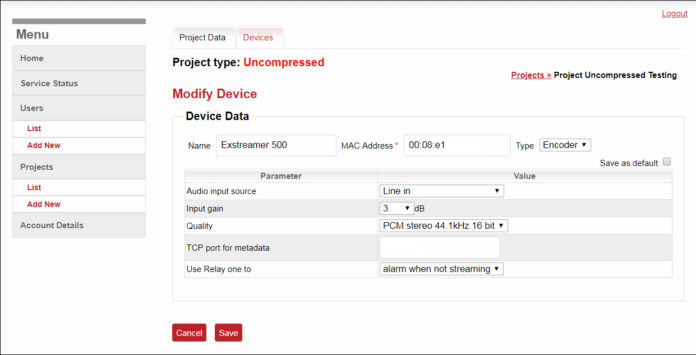For many radio industry engineers and tech pros, it’s all about workflow. That’s why Humboldt County, Calif.-based streaming solutions firm StreamGuys and IP audio firm Barix can’t wait to show off two new workflows for radio broadcasters that could only happen thanks to a partnership between the two companies.
Leveraging new support for uncompressed audio streams with metadata in the companies’ joint Reflector stream delivery and management service, the first workflow enables cloud-based encoding architectures that reduce customers’ costs and expand their output capabilities, while the second improves audio quality for point-to-point transport such as studio-to-transmitter links (STL).
The new offerings will be showcased at IBC2018 in Amsterdam; StreamGuys will co-exhibit with partner ENCO at the event.
Developed by Barix and hosted, operated and supported by StreamGuys, the Reflector managed service allows broadcasters and content producers to create IP-based audio delivery links without network and firewall configuration effort. Audio from a Barix hardware endpoint is transported across StreamGuys’ content delivery network, while link management is simplified through a cloud-based portal. The new Uncompressed Reflector Service builds on this foundation with support for uncompressed PCM audio accompanied by associated metadata, enabling flexible new workflows with superior sound quality.
Encoding and packaging audio streams for multi-format, multi-bitrate distribution has typically required customers to buy and managefull-featured encoding systems, many of which are Windows-based and need frequent operating system patches for security.
“StreamGuys’ new cloud-based encoding solution combines the dependability of dedicated Barix hardware with the reduced maintenance burden of a managed service and the virtually unlimited resources of the cloud, lowering users’ total cost of ownership while dramatically expanding their simultaneous, multi-format output capabilities,” the companies note.
The cloud-based encoding workflow starts with a current-generation Barix Exstreamer 500 encoder/decoder unit, which uses the Uncompressed Reflector Service to transport uncompressed audio to the Barix Uncompressed Gateway running on StreamGuys’ broadcast-grade cloud infrastructure. Support for accompanying metadata allows the transmission of program data such as song and artist information alongside the audio, and can be used to trigger downstream systems such as server-side ad insertion. StreamGuys’ virtualized Remote Encoder software then transforms the uncompressed audio into any desired combination of compression formats, bitrates and profiles for multi-format, multi-point distribution applications including live Internet broadcasting, multi-station radio networks, program syndication and more.
The Reflector service was previously best known for streamlining point-to-point audio transport for STL, studio-to-studio, station-to-station syndication and remote contribution links, and the Uncompressed Reflector Service offers benefits for these delivery architectures as well. Uncompressed PCM audio with metadata can be transported between two current-model Barix Exstreamer 500 hardware endpoints, combining robust reliability and operational simplicity with unparalleled audio quality. The flexibility of the Uncompressed Reflector Service also allows a single Barix Exstreamer 500 unit to simultaneously serve as the source for both cloud-based encoding and point-to-point delivery to Barix receiving devices, maximizing customers’ investments.
“The Uncompressed Reflector Service makes uncompressed remote contribution and backhaul much simpler and more reliable, forming a critical foundational element as the industry moves towards a fully-virtualized studio in the cloud,” StreamGuys President Kiriki Delany said. “Our new cloud encoding workflows enable customers to minimize on-site hardware at the studio, maximize their output capabilities and avoid the headaches of maintaining their own encoding systems, while our uncompressed point-to-point delivery architectures ensure that IP audio is transported between sites at optimal quality. We received tremendous response to our preview of these new workflows earlier this year, and we are looking forward to showcasing them to IBC attendees.”





